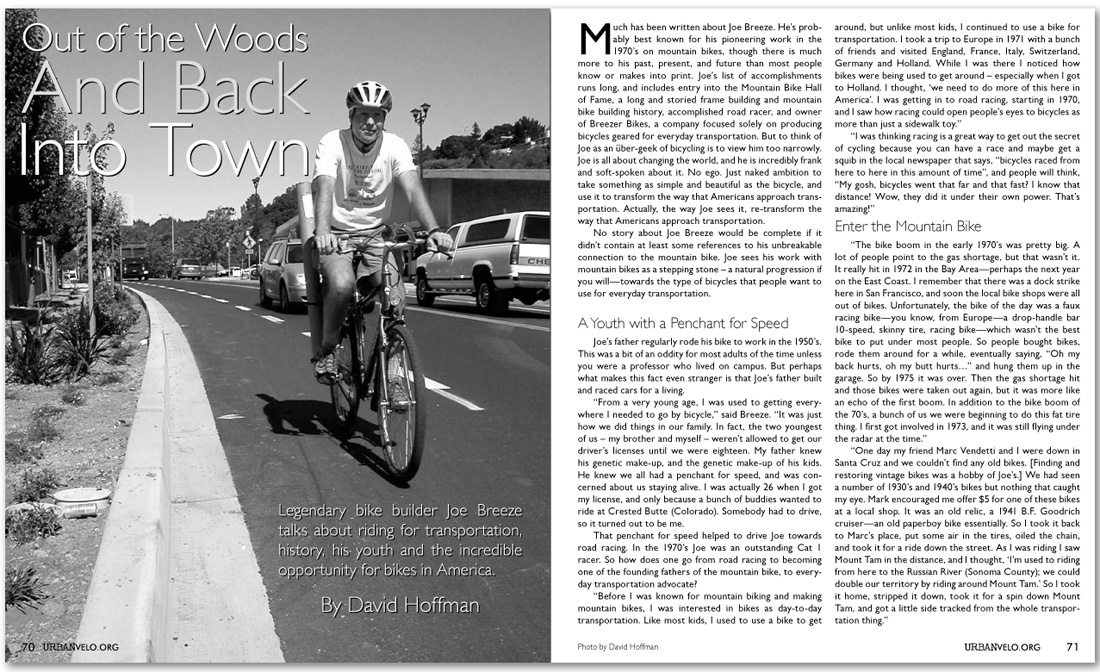Much has been written about Joe Breeze. He’s probably best known for his pioneering work in the 1970’s on mountain bikes, though there is much more to his past, present, and future than most people know or makes into print. Joe’s list of accomplishments runs long, and includes entry into the Mountain Bike Hall of Fame, a long and storied frame building and mountain bike building history, accomplished road racer, and owner of Breezer Bikes, a company focused solely on producing bicycles geared for everyday transportation. But to think of Joe as an über-geek of bicycling is to view him too narrowly. Joe is all about changing the world, and he is incredibly frank and soft-spoken about it. No ego. Just naked ambition to take something as simple and beautiful as the bicycle, and use it to transform the way that Americans approach transportation. Actually, the way Joe sees it, re-transform the way that Americans approach transportation.
No story about Joe Breeze would be complete if it didn’t contain at least some references to his unbreakable connection to the mountain bike. Joe sees his work with mountain bikes as a stepping stone – a natural progression if you will—towards the type of bicycles that people want to use for everyday transportation.
A Youth with a Penchant for Speed
Joe’s father regularly rode his bike to work in the 1950’s. This was a bit of an oddity for most adults of the time unless you were a professor who lived on campus. But perhaps what makes this fact even stranger is that Joe’s father built and raced cars for a living.
“From a very young age, I was used to getting everywhere I needed to go by bicycle,” said Breeze. “It was just how we did things in our family. In fact, the two youngest of us – my brother and myself – weren’t allowed to get our driver’s licenses until we were eighteen. My father knew his genetic make-up, and the genetic make-up of his kids. He knew we all had a penchant for speed, and was concerned about us staying alive. I was actually 26 when I got my license, and only because a bunch of buddies wanted to ride at Crested Butte (Colorado). Somebody had to drive, so it turned out to be me.
That penchant for speed helped to drive Joe towards road racing. In the 1970’s Joe was an outstanding Cat 1 racer. So how does one go from road racing to becoming one of the founding fathers of the mountain bike, to everyday transportation advocate?
“Before I was known for mountain biking and making mountain bikes, I was interested in bikes as day-to-day transportation. Like most kids, I used to use a bike to get around, but unlike most kids, I continued to use a bike for transportation. I took a trip to Europe in 1971 with a bunch of friends and visited England, France, Italy, Switzerland, Germany and Holland. While I was there I noticed how bikes were being used to get around – especially when I got to Holland. I thought, ‘we need to do more of this here in America’. I was getting in to road racing, starting in 1970, and I saw how racing could open people’s eyes to bicycles as more than just a sidewalk toy.”
“I was thinking racing is a great way to get out the secret of cycling because you can have a race and maybe get a squib in the local newspaper that says, “bicycles raced from here to here in this amount of time”, and people will think, “My gosh, bicycles went that far and that fast? I know that distance! Wow, they did it under their own power. That’s amazing!”
Enter the Mountain Bike
“The bike boom in the early 1970’s was pretty big. A lot of people point to the gas shortage, but that wasn’t it. It really hit in 1972 in the Bay Area—perhaps the next year on the East Coast. I remember that there was a dock strike here in San Francisco, and soon the local bike shops were all out of bikes. Unfortunately, the bike of the day was a faux racing bike—you know, from Europe—a drop-handle bar 10-speed, skinny tire, racing bike—which wasn’t the best bike to put under most people. So people bought bikes, rode them around for a while, eventually saying, “Oh my back hurts, oh my butt hurts…” and hung them up in the garage. So by 1975 it was over. Then the gas shortage hit and those bikes were taken out again, but it was more like an echo of the first boom. In addition to the bike boom of the 70’s, a bunch of us we were beginning to do this fat tire thing. I first got involved in 1973, and it was still flying under the radar at the time.”
“One day my friend Marc Vendetti and I were down in Santa Cruz and we couldn’t find any old bikes. [Finding and restoring vintage bikes was a hobby of Joe’s.] We had seen a number of 1930’s and 1940’s bikes but nothing that caught my eye. Mark encouraged me offer $5 for one of these bikes at a local shop. It was an old relic, a 1941 B.F. Goodrich cruiser—an old paperboy bike essentially. So I took it back to Marc’s place, put some air in the tires, oiled the chain, and took it for a ride down the street. As I was riding I saw Mount Tam in the distance, and I thought, ‘I’m used to riding from here to the Russian River (Sonoma County); we could double our territory by riding around Mount Tam.’ So I took it home, stripped it down, took it for a spin down Mount Tam, and got a little side tracked from the whole transportation thing.”
